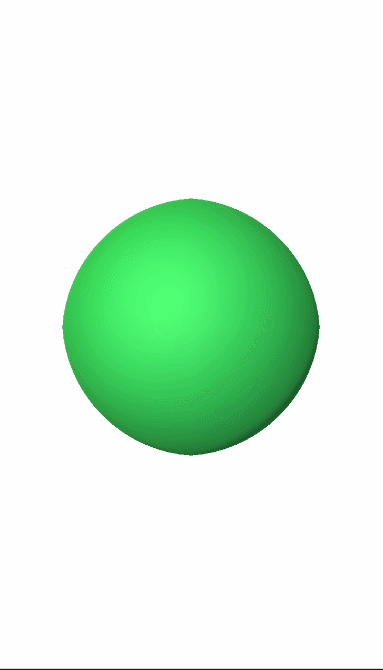
The effect drawing is as above. The effect production is divided into three parts, one is extrusion, one is drag, and the other is restoration.
First, let's talk about extrusion. First, there is an extrusion area. First, we need to obtain all vertices on the model, and the collider of the model will change with the change of the model, because only in this way can the collision be fed back in real time. Define the extrusion area and judge whether all vertices are in the extrusion radius of the circle centered on the mouse position. If they are in the circle, its y coordinate is interpolated to 0. On the contrary, nothing will change.
2 besides drag, drag also needs to judge the drag area and whether all vertices are in the drag radius with the mouse position as the center circle. If they are in the park, the drag direction is also the current coordinate of the mouse - the last coordinate of the mouse.
3 finally, to restore, we first record the initial coordinates, and then interpolate the current coordinates of each frame to the initial coordinates.
The code is as follows: first, post the extruded code
float dist = Vector2.Distance(new Vector2(_verts[i].x, _verts[i].z), new Vector2(point.x, point.z));
if (_isUsingPush)
{
if (point.y > _minYpoint)
{
if (dist < _pushRadius)
{
_verts[i].y = Mathf.Lerp(_verts[i].y, 0,
Mathf.Pow(1 - Mathf.Pow(dist / _pushRadius, _pushFalloff * _pushMagnitude2), 2) *
_pushIntsity * _pushMagnitude);
}
}
}dist is the two-dimensional distance between the current vertex and the mouse point (ignoring the y coordinate). Here, the value of t is interpolated. If the value in the center of the circle is 1, on the contrary, the smaller the value is, so 1-value is required. All functions of the value here are mathf pow, of course, other functions can also be used here, and so can linear functions. pow is mainly used here to be gentle.
The following is the drag and drop. The code is as follows:
if (_isDrag)
{
if (dist < _dragRadius)
{
float distance2 = Mathf.Pow((1 - Vector3.Distance(_verts[i], point) / _dragRadius / 2), _dragFalloff);
float drag = _dragIntensity * distance2 * DragStr * _speedMagnitude;
_verts[i] -= _movePos[tochId] * drag;
}
}Similarly, the value here is the same as that of extrusion. The pow function is used, and the 1-value is also required.
The last step is to restore. We update it in FixedUpdate.
The code is as follows:
private void FixedUpdate()
{
if (_isRepair)
{
for (int i = 0; i < _verts.Length; i++)
{
Vector2 v1 = new Vector2(_verts[i].x, _verts[i].z);
Vector2 v2 = new Vector2(_originVerts[i].x, _originVerts[i].z);
float dist2 = 1 + Vector2.Distance(v1, v2) * _rubber;
_verts[i] = Vector3.Lerp(_verts[i], _originVerts[i], _repairSpeed * Time.deltaTime * dist2);
}
_mesh.vertices = _verts;
_meshCollider.sharedMesh = _mesh;
_meshFilter.mesh = _mesh;
_meshFilter.mesh.RecalculateNormals();
}
}The value of dist2 here needs to be added with 1 by default, because if dist2 is not added with 1 when the distance is 0, dist2 will not be restored. So the whole code is as follows:
using UnityEngine;
using System.Collections;
public class MeshDeformate : MonoBehaviour
{
[SerializeField] private bool _isUsingPush;
[SerializeField] private bool _isRepair;
[SerializeField] private bool _isDrag;
[Header("Push")]
[SerializeField] private float _minYpoint = 0;
[SerializeField] private float _pushRadius = 0.1f;
[SerializeField] private float _pushIntsity = 0.2f;
[SerializeField] private float _pushFalloff = 2f;
[Header("Drag")]
[SerializeField] private float _dragRadius = 0.5f;
[SerializeField] private float _dragIntensity = 0.2f;
[SerializeField] private float _dragFalloff = 5f;
[SerializeField] private float DragStr = 0.1f;
[SerializeField] private float _repairSpeed= 0.4f;
[SerializeField] private float _rubber = 6f;
[SerializeField] private float maxMagnitude = 0.2f;
private Vector3[] _verts;
private Vector3[] _originVerts;
private Vector3[] _oldhPos = new Vector3[5];
private Vector3[] _movePos = new Vector3[5];
private float _pushMagnitude;
private float _pushMagnitude2;
private float _speedMagnitude;
private Mesh _mesh;
private MeshFilter _meshFilter;
private MeshCollider _meshCollider;
private bool _firstPush;
private void Awake()
{
_meshCollider = transform.GetComponent<MeshCollider>();
_meshFilter = transform.GetComponent<MeshFilter>();
_mesh = _meshFilter.mesh;
_verts = _mesh.vertices;
_originVerts = _mesh.vertices;
}
private void Update()
{
if (Input.GetMouseButtonDown(0))
{
_firstPush = true;
}
if (Input.GetMouseButton(0))
{
var ray = Camera.main.ScreenPointToRay(Input.mousePosition);
RaycastHit hit;
if (Physics.Raycast(ray, out hit))
{
if (hit.collider)
{
ModifyMesh(hit, 0);
}
}
}
}
private void FixedUpdate()
{
if (_isRepair)
{
for (int i = 0; i < _verts.Length; i++)
{
Vector2 v1 = new Vector2(_verts[i].x, _verts[i].z);
Vector2 v2 = new Vector2(_originVerts[i].x, _originVerts[i].z);
float dist2 = 1 + Vector2.Distance(v1, v2) * _rubber;
_verts[i] = Vector3.Lerp(_verts[i], _originVerts[i], _repairSpeed * Time.deltaTime * dist2);
}
_mesh.vertices = _verts;
_meshCollider.sharedMesh = _mesh;
_meshFilter.mesh = _mesh;
_meshFilter.mesh.RecalculateNormals();
}
}
private void ModifyMesh(RaycastHit hit, int tochId)
{
if (_firstPush)
{
_oldhPos[tochId] = hit.point;
_firstPush = false;
}
_movePos[tochId] = _oldhPos[tochId] - hit.point;
var point = transform.InverseTransformPoint(hit.point);
_movePos[tochId].y = 0;
_speedMagnitude = 0;
if (_movePos[tochId].magnitude < maxMagnitude)
{
_speedMagnitude = maxMagnitude - _movePos[tochId].magnitude;
_pushMagnitude = 1 + _movePos[tochId].magnitude * 2;
_pushMagnitude2 = 1 + _movePos[tochId].magnitude * 2;
}
Debug.LogError(_movePos[tochId]);
for (int i = 0; i < _verts.Length; i++)
{
float dist = Vector2.Distance(new Vector2(_verts[i].x, _verts[i].z), new Vector2(point.x, point.z));
if (_isUsingPush)
{
if (point.y > _minYpoint)
{
if (dist < _pushRadius)
{
_verts[i].y = Mathf.Lerp(_verts[i].y, 0,
Mathf.Pow(1 - Mathf.Pow(dist / _pushRadius, _pushFalloff * _pushMagnitude2), 2) *
_pushIntsity * _pushMagnitude);
}
}
}
if (_isDrag)
{
if (dist < _dragRadius)
{
float distance2 = Mathf.Pow((1 - Vector3.Distance(_verts[i], point) / _dragRadius / 2), _dragFalloff);
float drag = _dragIntensity * distance2 * DragStr * _speedMagnitude;
_verts[i] -= _movePos[tochId] * drag;
}
}
}
_oldhPos[tochId] = hit.point;
_mesh.vertices = _verts;
_meshCollider.sharedMesh = _mesh;
_meshFilter.mesh = _mesh;
_meshFilter.mesh.RecalculateNormals();
}
}
The whole code is finished, and finally the project source code is posted Baidu online disk, please enter the extraction code
Extraction code: mxp9